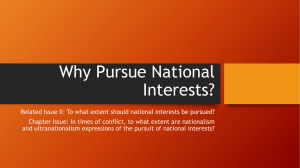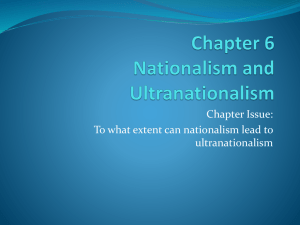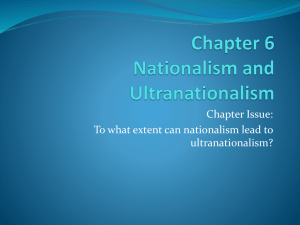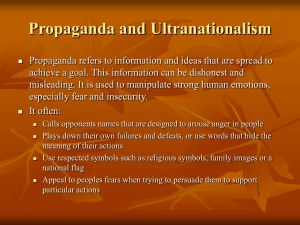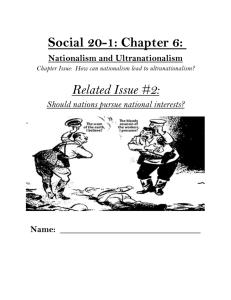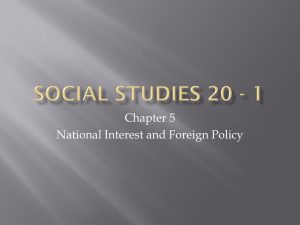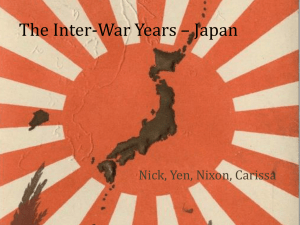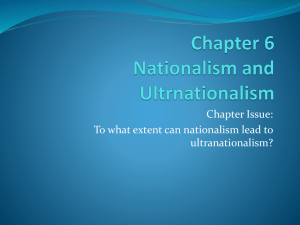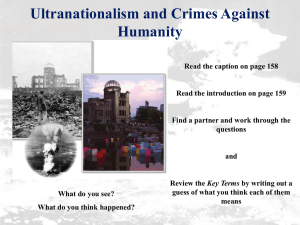How Have People Responded to Ultranationalism?
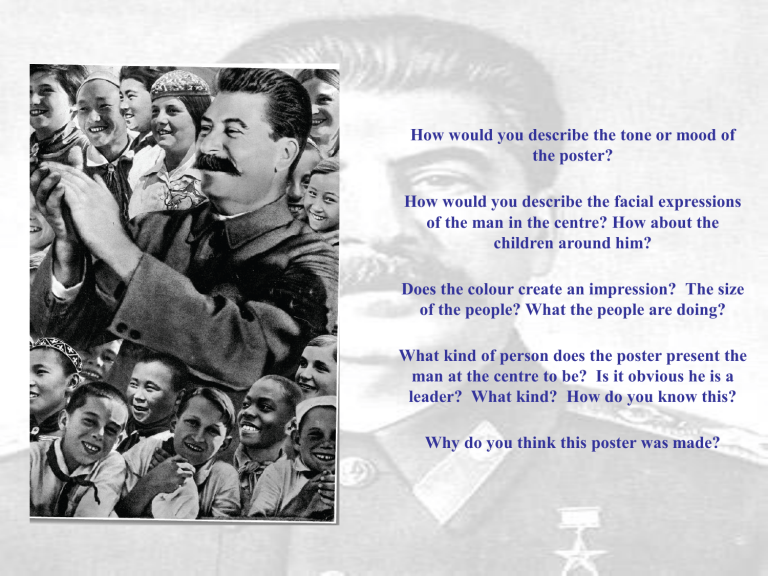
How would you describe the tone or mood of the poster?
How would you describe the facial expressions of the man in the centre? How about the children around him?
Does the colour create an impression? The size of the people? What the people are doing?
What kind of person does the poster present the man at the centre to be? Is it obvious he is a leader? What kind? How do you know this?
Why do you think this poster was made?
Nationalism and Ultranationalism
Review the map, including the legend
What does SSR stand for?
The SSR countries were countries that were directly controlled by Russian dictator Joseph Stalin
Read the caption on page 130
Read the introduction and complete all of the questions on page 131
Review the key terms
Do you know what they mean?
What is Ultranationalism?
Review and recreate the exploding concept in your notes
Read the top half of page 132
Ultranationalism is an extreme form of nationalism
Nationalism
Ultranationalism
What do you think this scale means?
Where does nationalism end and ultranationalism begin?
Examples?
Read the rest of page 132
Respond to Figure 6-2
Ultranationalism in Kosovo and the USSR
Using this handout and a partner, read pages 133 – 134 and record examples of
Ultranationalism
Remember to review all photographs and margin features
Rank the tactics based on the harm they can do
Do ends justify the means?
Why or why not?
Complete the Recall,
Reflect, Respond on page 135
Read page 135
Review the bulleted information
Rank the tactics used by propagandists on a scale of 1 to 5
(1 = Very Effective – 5 = Not Very Effective)
Read the caption to this picture on page 135
What do you think is so disturbing about this picture?
What is the connection between these two photographs?
Read the caption to this picture on page 135
Do you think the Nazi tactic of using propaganda on children is acceptable?
Why or why not?
The use of propaganda as an example of
Ultranationalism
Hitler’s Children
48 minutes
Inside the Reich
12 minutes
How Does Ultranationalism Develop?
What benefits are there for an author of a textbook to create an outline before anything is written?
How can one identify the outline of a textbook?
For a textbook, the outline can often be found in the headings and subheadings
For this section of the textbook, recreate the author’s outline by recording a list of all the headings in pages 136 – 140
Be sure you differentiate between the three different levels your textbook uses
First level or H1 or A:
Section Heading
(in red)
Second level or H2 or B: Subheading (in blue)
Third level or H3 or C: Subheading (in green)
What two countries will the section focus on? What period of history? Which page of subsection do you think will be the most interesting? The least interesting?
How would you answer the inquiry question at this point?
How Does Ultranationalism Develop?
Read the opening paragraph on page 136
List in your notebooks the factors that can contribute to the development of ultranationalism:
A Social or Economic Crisis
A Charismatic, powerful leader
National symbols and myths that promote feelings of superiority
How might a crisis affect people’s sense of nationalism and national identity?
Imagine that Canada was attacked like the United States was attacked on 9/11…
Would it make people more nationalistic or less nationalistic?
Would it unite Canadians of all backgrounds or cause suspicion and anger?
Would such a crisis make Canadians support their government more or less?
How Does Ultranationalism Develop?
Read the section on page 136 Countries in Crisis
Factors That Can Contribute to the
Development of Ultranationalism Between the two of you, decide who will be the German expert and who will be the Japanese expert
The German expert will read the rest of page 136 and the Japanese expert will read the top of page 137
Using the top left-hand side of the handout, work together to record one example of a crisis that contributed to ultranationalism for both of the readings
Everyone needs to find the handout and a partner
Charismatic Leaders
Brainstorm a list of important or famous world leaders
What does the word
Charisma mean?
Why have you heard of these leaders?
How can leaders who are charismatic be linked to ultranationalism?
Many famous
(or infamous) leaders are well-known because of what they have accomplished; they are/were good speakers; they were widely reported in the media; or were just a great leader
Take out your chart
Factors That Can
Contribute to the
Development of
Ultranationalism
Read the introduction on page 138
The German experts read the section titled
Adolf Hitler in Germany
The Japanese expert read the section titled
Hirohito and Tojo in Japan
Add one example of a charismatic leader who contributed to the rise of ultranationalism and add this new information to the right-hand side of your handout
Review this poster.
Is there anything that strikes you as charismatic?
This poster from the mid-1930’s makes a direct Christological comparison.
Just as a dove descended on Christ when he was baptized by John the
Baptist, so what looks to be an eagle hovers against the light of heaven over an idealized Hitler. The text:
"Long live Germany!."
What is significant about this similarity?
Hitler’s charismatic rise to power…
Instilling Ultranationalist Values
Read the introduction on page 139
The German expert will read the rest of page
139 and the Japanese expert will read all of page 140
Read all the margin features!
Add one example each of instilling ultranationalistic values to your handout to the bottom of your handout
Factors That Can Contribute to the
Development of Ultranationalism
When your handout is complete, decide which of these three factors is most significant in the development of ultranationalism
When you are finished, complete the Activity on page 139 with your partner
Germany & The Great Depression
Complete the Recall, Reflect, Respond on page 140 when you are finished
Review Figures 6-9 and 6-10 and their captions on page 136
What might happen in Fort Saskatchewan if people were losing their jobs and homes?
What if the price of a loaf of bread rose from
$2.00 to $6 million in six years?
Respond to the Activity on page 136
Before You Leave Today…
You will need to complete and hand in the following:
First they came for the communists, and I did not speak out - because I was not a communist;
Then they came for the Jews, and I did not speak out - because I was not a Jew;
Then they came for the trade unionists, and I did not speak out - because I was not a trade unionist;
Then they came for the Catholics, and I did not speak out - because I was not a Catholic;
Then they came for me - and by that time, no one was left to speak up.
(Understanding Nationalism – Page 141)
Authored by Martin Neimoeller, a German Lutheran pastor and anti-Nazi activist who spent eight years in a German concentration camp.
He wrote this to explain why some people did not take action against the Nazi regime during the 1930’s and 1940’s
What is Neimoeller saying about why some people failed to take action?
Does Neimoeller sound critical or not? What makes you say this?
Why might people have failed to speak up? In a similar situation, would you?
How might people who failed to take action have felt when they became aware of the
Holocaust?
What does this poem tell you about the importance of recognizing and guaranteeing the human rights of all peoples?
German Civilians Tour Buchenwald Camp
After the Buchenwald concentration camp was liberated in April, 1945, the German civilians from the nearby town of
Weimar were brought to see the evidence of Nazi atrocities.
Failure to act is only one response to ultranationalism…
This is only a part of what they saw
Auschwitz
How Have People Responded to
Ultranationalism?
As you have just appreciated, failure to act is one response to ultranationalism.
Can you think of other possible responses?
Right now, we’re going to look at a five other responses to the inquiry question above
The class will be divided up into five groups, each group responding to one of the questions below. After being assigned a group, write out the corresponding question and page numbers
1.
Should people respond to ultranationalism by appeasement?
(Pages 141 – 142)
2.
Should people respond to ultranationalism by going to war?
(Page 143)
3.
Should a country use propaganda and censorship in wartime?
(Page 144 and the four posters at the bottom of pages 144-145)
4.
Should a country use conscription to fight a war?
(Page 145)
5.
Should a country put ‘enemy aliens’ in internment camps during a war?
(Page 146)
How Have People Responded to
Ultranationalism?
YES NO
In your groups, write your assigned question at the top of your chart paper
Below your question, make a ‘T-Chart’, with the ‘Yes’ and
‘No’, like the one here
Individually, each members in your group are to read their assigned section, checking all visuals and margin features
– ignoring any Activities
After reading, discuss with your group one or two reasons to support (Yes) or to oppose (No) the approach in their question. Write these on your chart paper
Here are some hints…
Give an example – is it working of failing
List a drawback or benefit
Who gets hurt – and how?
Who benefits – and how?
When all groups are done, your group will trade chart papers with another group that is complete
Complete this process until you have read all five sections
Discuss
How Have People Responded to
Ultranationalism?
Review Figure 6-17 on page 141 and complete the Activity on the same page
Complete the Activity on page 142
The Suez Canal
What do you know about the Suez Canal?
The Suez Canal is more than 195 kilometers long and at least 60 meters wide
It takes approximately 15 hours to travel from one end of the canal to the other
Why do you think the canal was built where it was?
As you read page 148, keep in mind the following question:
How is peacekeeping a response to ultranationalism?
Before World War Two started, why wasn’t the
League of Nations able to stop the conflict?
Is an attempt to keep peace so a resolution can be found before conflict breaks out an action?
Was it worthy of the Nobel
Peace Prize – or not?
Skill Builder to Your Challenge
Review Challenge #2 on pages 106 – 107
Have you chosen your ‘nation’ yet?
Have you decided what format your museum presentation will take?
On Thursday, the answers to the following questions are due and will be handed in
What nation are you choosing for your display?
Where will you find (or found) the historical map? Be Specific!
What format of propaganda are you going to use?
Where will you find your propaganda? Be specific!
What format are you going to use to present your display?
Note: If you use any electronic format to present your display, you will have to explain to the class the details
All other non-electronic methods do not have to be verbally explained
